A grandiose tomb"Not since antiquity had the western world seen such a grandiose individual tomb" (Henri Zerner, 374). It is not just an elaborate sarcophagus, but a freestanding monument, an architectural enclosure, like an Italian tempietto. |
| Commissioned by Francis I (the successor to Louis XII), this tomb was designed by Florentine sculptors, the Guisti, residing in France. Scholars comment on its echo of Michelangelo's first plan for the tomb of Pope Julius, another freestanding scheme with multiple figures. |
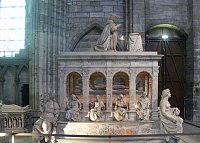
|
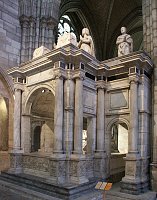
|
| |
|
| The arched canopy, underneath which the two are shown dead, is decorated with statues of the Apostles (see Saint Peter below) as well as the four cardinal virtues at the corners. The reliefs on the side depict the king's deeds (battle relief is shown below) while above the couple kneels in prayer--a symbol of their resurrection. Zerner comments on the development of kneeling effigy, what Panofsky called "the activation of the effigy": "The deceased ceased to be represented lying on a parade bed. The older formula had the advantage of gracefully articulating the passage from one life to another, recalling the exhibition of the corpse during funeral rites, while anticipating an awakening to eternal life. Suddenly, the effigy drew itself upright and knelt in prayer. However, the statue did not pray in a void; these kneeling individuals turn toward the altar and to the divine figures placed on it. Such funeral portraits are only comprehensible within the transcendental space--both real and fictional--of the church, shared by the faithful and statues" (373). |
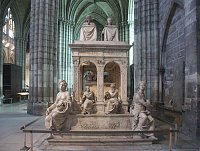
|

|
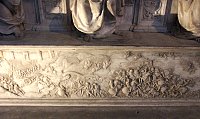
|
| |
|
The Four Cardinal Virtues at the corners--the right personified abstraction being PrudenceBlunt sees these allegorical statues as being Florentine in derivation but specifically connected with Andrea Sansovino's style. He says they are interesting only in so far as they are "among the few surviving examples of Italian High Renaissance sculpture which reached France at this period, though they cannot have given Frenchmen much idea of what was being produced at the period in Italy" (40). However, Blunt analyzes the gisants, the recumbent figures, in detail and finds much of interest. I do not have details of these figures since one is prevented from getting close to the ensemble. |
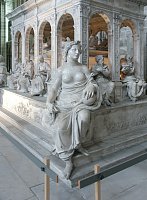
|
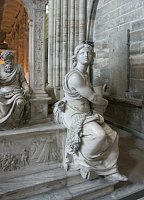
|
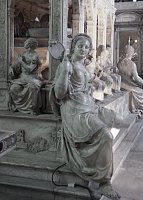
|


 Click here to return to index of art historical sites.
Click here to return to index of art historical sites.
 Click here to return to index of artists and architects.
Click here to return to index of artists and architects.
 Click here to return to chronological index.
Click here to return to chronological index.
 Click here to see the home page of Bluffton University.
Click here to see the home page of Bluffton University.

